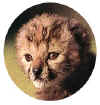
Welcome
to the cheetah page
"The
fastest cat in the world"

please
enjoy!

This site is dedicated to the
Cheetah. The cheetah is yet, one of a number of cats that is endangered.
Preservation, protection, and an understanding will help the cheetah survive in
today's world.


cheetah
facts:
 | fastest
cat that can reach speeds of up to 65 miles per hour(98km). |
 | Use
their brilliant speed to catch their prey. Unlike tigers and lions who
stalk their prey. |
 | Cheetahs do
not roar but rather chirp like birds. |
 | Can range
from 80 pounds to 120 pounds in size. |
 | The
characteristic lines below this cats eyes are said to reduce glare
from sunlight. |
 | tail is used
as a balance for high speed running. This allows the cat to make high speed
turns without any effort. |
 | Hunt in the
daylight hours. |
 | Tail
measures 26-33 inches in length. |
 | The cheetahs
body is streamlined to help it accelerate to such fast speeds. |
 | Cheetahs
diet is based on Gazelle, Impala, hares, and Wildebeest calves. |
 | Only 55% of
all Cheetah hunts are successful. |
 | The only cat
with non-retractable claws. |
 | Have light
brown-yellow coats with round black spots. |

Cheetah
Range: Please view the map
 click
to enlarge
click
to enlarge
-Darker
areas note higher density, black dots define protected areas-

Saving the
Cheetah
There are ways we can save the Cheetah. Through
interaction and flow of information between ranchers and animal rehabilitators.
This would involve, trapping problem cheetah's and transporting them to
sanctuaries or new animal reserves. An example would include AfriCat
headed by Lise Hanssen. Their primary job is to retrieve Cheetahs that have been
trapped in cages set up by ranchers. Ranchers usually call AfriCat to let them
now that a cat has been trapped in one of their cages. Cats are then
tranquilized and transported to a safe facility where they are given a medical
examination. As soon as everything looks good the cat is taken to a ranch for a
6 week quarantine. The cat is then released into a reserve for reintroduction
into thee large-carnivore reintroduction program.
That's why ranchers play a important part in the
preservation of the Cheetah. If we can get the ranchers to help us to preserve
this beautiful animal then we are one step closer to preserving the Cheetah.

Some photo's of this incredible
cat:




links to other pages:
The
cheetah, lion, and leopard farm
Wildlife
news
The
cheetah conservation fund
Conserve
big cats of africa(AfriCat)

![]() on 09/05/00 12:04:41 AM added
photo gallery
on 09/05/00 12:04:41 AM added
photo gallery
![]()









